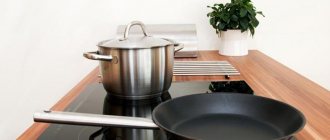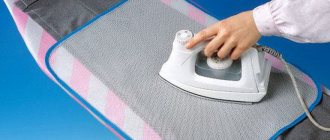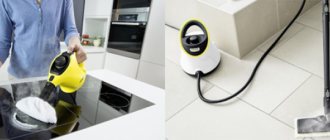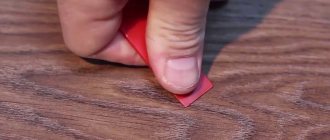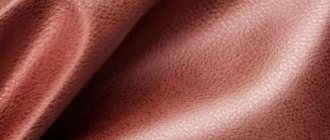A glass-ceramic stove is the dream of any housewife. But this is at first glance. For an aesthetic appearance and almost instant heating, you have to pay for the hassle of care.
To ensure that your beautiful stove remains clean longer and that nothing gets spoiled, experienced housewives suggest following these tips. Perfect cleanliness in the kitchen is guaranteed!
Glass ceramics are a fragile thing and require care.
Tips from this list were collected from housewives from all over the world. They will greatly facilitate the maintenance of an induction hob with a glass-ceramic surface. And at the same time they will help you save money on the purchase of special cleaning products and scrapers.
How to properly clean a hob?
Here are the recommendations of experts.
It's that simple. But... there are a number of other recommendations related to different specific cases. What do experts advise?
• Never wipe the surface with a dishwashing sponge, as There may be traces of grease or detergent that will burn the next time you turn it on and lead to discoloration of the surface. Clean the glass ceramics around the hotplates with soapy water applied to a soft cloth (Beko recommendations).
• Remove lime and water marks, grease splashes and stains with a metallic sheen that change the color of the surface using standard ceramic cleaners or stainless steel cleaners. Detergents must not come into contact with the hot glass ceramic hob! All detergents must be removed after cleaning with sufficient clean water as they may be corrosive when subsequently heated (Electrolux warns).
• Using dishwashing detergent to clean glass ceramics may cause bluish stains. They are difficult to remove even with special means, but do not affect the operation of the panel. Limescale residues can be removed with vinegar (recommends Kaiser).
• It is not recommended to clean glass ceramics with oven spray or stain removers (AEG experts write).
• Clean glass ceramics with glass cleaner (Ardo recommends).
• Damage to the hob can be caused by grains of sand falling on the hob, for example when peeling vegetables (see Siemens).
• Make sure that the surface of the burners is always dry, as salt water or wet pan bottoms can damage it (Siemens advises).
Good dishes can be identified by their bottom
Another “pressing” question that often bothers us when purchasing glass-ceramic stoves is related to what kind of cookware is recommended to be used.
Everyone knows that the size of the bottom of pots and pans should correspond to the diameter of the burner. This must be written in the instructions for each stove and a diagram showing the correct and incorrect position of the pan is attached.
But it is not clear to everyone what materials it is recommended to buy dishes from. Some manufacturers write that aluminum and copper pans cannot be used, others that they can. In principle, cooking in this cookware is not prohibited. But specific pearlescent stains may remain on glass ceramics, and it is very difficult, sometimes impossible, to wash them off.
Good cookware is determined by the bottom of the pan, and not by the material, Electrolux reminds. The bottom should be as thick and even as possible. It is not recommended to use pans with damaged bottoms, rough surfaces or burrs, as they may leave permanent scratches when moved.
At room temperature, the bottom of the pan should be slightly concave, since it expands when heated and is in full contact with the hob. This provides heating with minimal heat loss. According to European standards DIN 44904, the maximum concavity of the bottom should not exceed 0.6% of the bottom diameter. For example, a pan with a bottom diameter of 220 mm should have a maximum concavity of 1.3 mm.
Ariston specialists warn - do not use dishes that were used to cook on a gas stove, as the bottom of these pans can be deformed due to the uneven impact of a strong flame, so full contact with the work surface becomes impossible.
You can use enamel cookware. The only thing is that you shouldn’t leave it empty on hot burners that are turned on. In this case, damage to the glass-ceramic surface may occur that cannot be repaired.
In principle, almost all pots and pans are written on what surfaces they are intended for. There must be a clear indication - “glass ceramics” or “ceramics”. If it is written simply - “for electric stoves”, then it means enameled work panels with “pancakes”.
If the glass-ceramic surface has induction burners, then the choice of pans should be taken even more seriously. Steel, enameled steel, cast iron frying pans and pots are suitable for induction. Pans with metal alloy bottoms (“sandwich”) are only suitable if specified by the cookware manufacturer. This means that the bottom contains a ferromagnetic element. In principle, you can check whether the saucepan you like fits your burner using a magnet. For induction burners, cookware made of aluminum, copper, brass, stainless steel (unless marked), glass, ceramics and porcelain cannot be used.
Another small but important note regarding all types of glass-ceramic burners: first place the cookware on the burner, and then turn on the last one.
What are glass ceramics afraid of?
• Glass ceramics do not like sugar, aluminum and plastic.
• It cannot be cleaned with steel wool, a knife or a brush.
• The use of abrasives is not recommended.
• Glass ceramics are resistant to mechanical stress and can withstand heavy loads, but are susceptible to pinpoint impacts, for example, a crack can appear as a result of a knife falling with the blade down. In practice, such a fall is extremely rare, but theoretically it is quite possible.
• Do not splash cold water onto a hot burner and try not to place a cold, wet pan on a hot burner that has not yet cooled down. Most likely nothing bad will happen, but sooner or later the coating may fail.
• If the liquid that “escaped” from the pan on one burner gets onto the adjacent burner that has not yet cooled down, the panel in this place may crack. It is not necessary that it will crack as soon as you spill liquid. But this could happen in, say, 10,001 cases. Glass ceramics love neat housewives.
• Do not use dirty or dry cloths for cleaning. They can serve you badly, and glass ceramics after such “cleaning” will become dirtier than before.
Large selection of equipment
If you are just looking for a new hob, pay attention to KRONA brand products. Gas, electric and induction panels combine traditional German quality and bright Italian design. In the company's online store you will find models with different numbers of burners, they can be from 2 to 5. Appliances with and without a frame are widely available. The equipment is made from durable and environmentally friendly materials.
Hobs are distinguished by wide functionality and exquisite design. Many surfaces are decorated with original patterns, for example Fidato 45 BL, Terzo 60 BL, Meridiana 60 WH, Inizio 45 BL and others. The most popular colors: white, black, silver (stainless steel), anthracite, ivory. A large selection of models on our website allows you to find the ideal option for any classic or modern interior.
Safe chemistry
Cleaning product
When choosing a cleaning product, carefully read the composition of the product. The main function of silicone is to create a protective surface that simplifies the removal of grease and prevents subsequent contamination.
Selena-extra. The product removes old fat. Shake the product before applying. The small amount of silicone present in the composition does not provide the proper cleansing effect.
Domax is an ideal product for daily cleaning of the stove. Removes stains, simple stains, cannot cope with old stains, requires the use of additional products. In terms of its action, it is an excellent surface polishing agent (it contains a larger amount of silicone). Any tiler will appreciate this type.
Dr. Beckman - copes well with fresh stains. If you need to remove dried stains, apply the product for a few minutes. There are no strong chemicals in the composition and does not irritate the skin of the hands.
Attention! With regular use, it creates a film coating that prevents the formation of dirt.
Cleaning old dirt
Before starting cleaning, the workplace must be prepared and unplugged. There are several options for how to wash a glass-ceramic stove without damaging the material.
There are several options for how to wash a glass-ceramic stove without damaging the material.
Removing carbon deposits is more difficult than ordinary dirt. Having the skills to effectively clean a ceramic hob from adhering carbon deposits, it will not be difficult to deal with the problem.
Having the skills to effectively clean a ceramic hob from adhering carbon deposits, it will not be difficult to deal with the problem.
To do this, you need to apply a special gel to dissolve fat on a surface previously washed with water. Soda paste will also work. After 30 minutes, remove from the contaminated area with a soft material.
Soda paste will also work.
Stubborn stains are ideally cleaned with a solution of water (250 ml) and ammonia (50 ml). The product is left on the contaminated area for 10 minutes, then wiped thoroughly with a dry cloth.
The product is left on the contaminated area for 10 minutes, then wiped thoroughly with a dry cloth.
There is an effective way to quickly clean a glass-ceramic stove from burnt dairy products. Olive oil applied to gauze, cotton pad or sponge is ideal for removal. The compress is applied for 30 minutes, after which the stain is removed with a sponge or metal scraper. The oil softens the plaque and makes it easier to wipe off.
There is an effective way to quickly clean a glass-ceramic stove from burnt dairy products.
Melamine sponge copes well with stubborn stains without adding chemicals. All you need to do is wet it with water and wipe the surface.
Melamine sponge copes well with stubborn stains without adding chemicals.
Regular table vinegar will also help remove stains. To prepare the cleanser, water and vinegar are mixed in equal proportions, poured into a spray bottle and sprayed onto the surface. After a few minutes, the solution is wiped with a dry cloth.
Regular table vinegar will also help remove stains.
In addition to the hob, the stove has small parts in the form of handles. It is much easier to clean the handles if they are removable. A soap or vinegar solution will help get rid of dirt.
It is much easier to clean the handles if they are removable
To obtain a soap solution, take 50 g of soap and 100 ml of hot water. Place the handles for 30 minutes, then remove the dirt. The vinegar solution is prepared in the following proportions: 2 tbsp. l. vinegar and 1 liter of water. Boil the handles in the prepared liquid for 5-7 minutes.
To obtain a soap solution, take 50 g of soap and 100 ml of hot water.
If the handles cannot be removed, cotton pads, a toothbrush or a toothpick, previously soaked in soda or ammonia, will come to the rescue.
If the handles cannot be removed, cotton pads, a toothbrush or a toothpick will come to the rescue.
Act now
It happens that even the most careful and attentive housewives may not keep track of everything during active culinary experiments. Therefore, it cannot be excluded that plastic objects, sweet ingredients of dishes, baking foil and other things may come into contact with the glass-ceramic surface, which can spoil the appearance of the stove. If something like this occurs, the advice from experts is clear - act immediately. Remove any dirt or foreign objects using a glass ceramic hob scraper. If you hesitate, they can melt and damage the glass ceramics.
Also, make it a rule to apply a glass-ceramic hob cleaner to the surface before starting to prepare sweet dishes. The product leaves behind a protective film that can protect the coating from getting sweets on it.
Glass ceramics is a fairly strong material, but still requires careful handling. Proper care of the surface and careful operation of the stove will preserve the attractive appearance and performance of the device for a long time. As a result, by following simple rules and adhering to the advice of experts, using a glass-ceramic stove will be a pleasure.
Watch him, otherwise he will run away...
The smooth surface of glass ceramics can be of poor service if a large amount of liquid is spilled on the panel. Naturally, it will flow down the walls of the stove onto the floor. It's good if it's just water, even better if it's clean. What if rich broth spills? You will have to wash not only the glass ceramics, but also the walls of the stove and the floor around it.
Another nuisance concerns not only glass-ceramic stoves. It’s not very common to find models with a heating zone of small diameter, which would fit under a cezve or a small geyser coffee maker. Lovers of coffee prepared in this way have to either violate the rules for operating the device, risking damage to the burner, or refuse to prepare their favorite drink.
More on the topic “Cleaning the stove: induction, glass-ceramic. What detergents should I choose?
Praise the induction tool
An ordinary sponge with dishwashing detergent, then a wet rag and dry it. If anything sticks, use cleaning milk. We have two glass-ceramic burners, two induction, a combination stove, so the induction ones are ideally clean, but the regular ones need to be scraped.
Premium built-in home appliances from LG: looks great - cooks smart
LG Electronics (LG) has announced a premium line of built-in household appliances for the Russian market, embodying the ideal combination of design and functionality so necessary for the modern rhythm and lifestyle. All products in the new family are specially designed and manufactured to be part of a complete kitchen appliance package, which includes everything you need to keep food fresh for a long time, as well as to prepare the most delicious dishes...
Premium home appliances from Samsung
As part of the Samsung Art of House film festival, a new line of premium household appliances was presented. The event was held in Teatralny in the style of a film awards ceremony. The host of the evening was Russian actress Valeria Lanskaya. Nine short films by emerging Russian directors were shown, who drew inspiration from the features of Samsung household appliances. The works of festival participants can be viewed here. A new premium...
Glass ceramics or circles (pancakes)????
I also choose an electric stove, but >. glass ceramics - induction. A friend's mother-in-law has arrived. I started cooking on glass ceramics as if I were cooking on gas - the stove burst. The glass ceramics are in their 7th year... Easier to clean than pancakes. Sugar... well, it happened a couple of times - so I cleared it right away and that’s it.
Help! Gas hob.
I have Bosch, just glass ceramics with large cast iron grates, just black. I don’t see anything capricious - I wash it with the usual products for glass ceramics and dishwasher racks. If I had thought about this during the renovation, I would have chosen a different stove model.
Who has dishes for glass ceramics?????I’m crying(((((
Induction cookers may have a glass-ceramic surface. Cleaning agent for glass ceramics - Schumanit, for example, and also buy a scraper and replacement blades for it - and everything will be cleaned.
How to clean tape and a question about a glass-ceramic stove.
Section: Cleaning (glue the glass-ceramic stove). How to clean tape and a question about a glass-ceramic stove. Even now, with a regular slab of detergent, I have enough detergent for six months 09/16/2009 21:48:45, Beatrice. There is one ironclad rule for induction cookers...
How to clean glass ceramics?
How to clean glass ceramics? Tell me, who cleans the stoves with what? Do you mean glass-ceramic? In the same place as glass ceramics. There are also cleaning products. I bought at the Prague market (where electronics and household appliances are).
Glass ceramic hob, maintenance.
Glass ceramic hob, maintenance. Tell me how to get rid of “rainbow” stains on the glass-ceramic surface of the stove. Glass ceramic cleaning products cannot be removed (I used Bagi, Komet, Pemolux-cream)).
Stupid question about hobs
I didn't want any edging either. In the end, I chose one with a edging, but made of the same glass ceramic as the surface itself. For now, only stove cleaning agent gets into the gap near the edging :)) I wipe it off. You need to wash it often, don’t let it run. 03/10/2005 13:16:28, Murzya.
Glass ceramic cleaner
Section: Washing, cleaning. Product for glass ceramics. How do you wash/protect your glass-ceramic panel? Dosya cleaning cream costs 20 rubles. It doesn’t seem to create a protective film, but even without it, I wash the stove just in case, and I’m not going to perform a feat, as was the case with...
How to clean an electric stove?
There is a product called SANITA-gel. how to clean this stuff. I like 11/24/2003 10:55:46 pm, Musya & Gusya. Rules for caring for glass ceramic hobs. how to get rid of it? lll. Which sink would you choose? Vitamin.
Folk remedies
Below are popular folk remedies for caring for glass ceramics.
Vegetable oil
Works great on tough and old stains. Saturate the sponge with a small amount of the substance, leave it on the stain for 30 minutes, after which you can remove the stain;
Baking soda + lemon juice
Make a paste by diluting baking soda with liquid. This paste is applied to burnt fat and burnt food. The applied composition remains on the surface for 15 minutes, after which it is removed with a soft cloth. If the contamination is strong, add lemon juice to the soda paste. After some time has passed after applying the composition, grease stains are destroyed and can be easily removed;
Vinegar 9%
Benefits: disinfection of equipment and cooking tools. The solution, vinegar and liquid, in equal proportions, are applied to the surface with a sprayer. Wipe with a paper towel.
Helpful tips for keeping your induction hob clean
- It is recommended to wipe the stove with a soft cloth and a special cleaner every day to avoid old stains.
- You can clean the stove only after it has completely cooled down, otherwise streaks may appear on the glossy surface.
- If there is noticeable dirt on the induction panel and you plan to turn it on in the near future, it is better not to do this. First, you should remove the stains and only then start cooking, since otherwise the remnants of previous culinary experiments can literally “weld” to the surface.
- It is strictly forbidden to use any abrasives, both chemical and natural (soda, mustard, etc.). Even the smallest grains leave scratches on the glossy glass ceramics, and it will be impossible to get rid of them later. If the question arises “how to clean an induction cooker?” - choose Schumanite for glass ceramics, and your kitchen will always be in order.
- To care for the stove, you should use a separate cloth, for example, lint-free microfiber, or use disposable towels. Hard sponges with a pronounced texture, brushes and steel wool - all this cannot be used so as not to damage the surface. Moreover, you should not use soft sponges with which you wash dishes or wipe tables - crumbs and particles of detergents may remain on them, which are contraindicated for induction cookers.
Preparation of special cleaning agents
Caring for glass ceramics at home is not difficult, but requires regularity. To avoid searching for numerous ways to remove old stains, it is important to read in advance the information on how to clean a glass-ceramic hob from possible dirt and deposits.
Caring for glass ceramics at home is not difficult, but requires regularity.
It is advisable to get rid of contaminants immediately after they form. Therefore, you will have to clean the panel daily after each cooking process.
It is advisable to get rid of contaminants immediately after they form.


